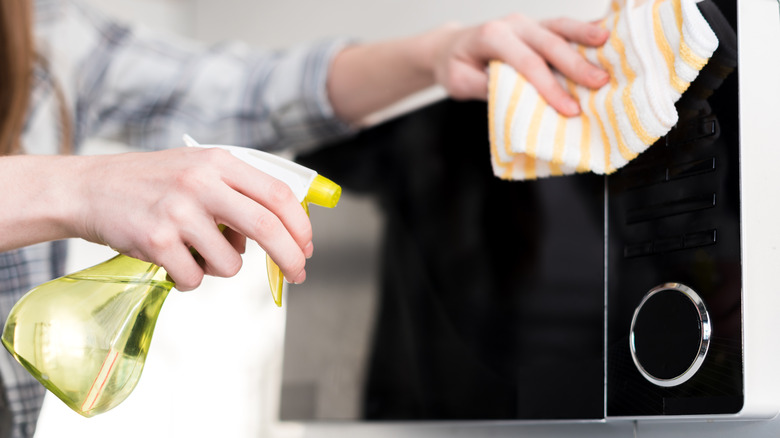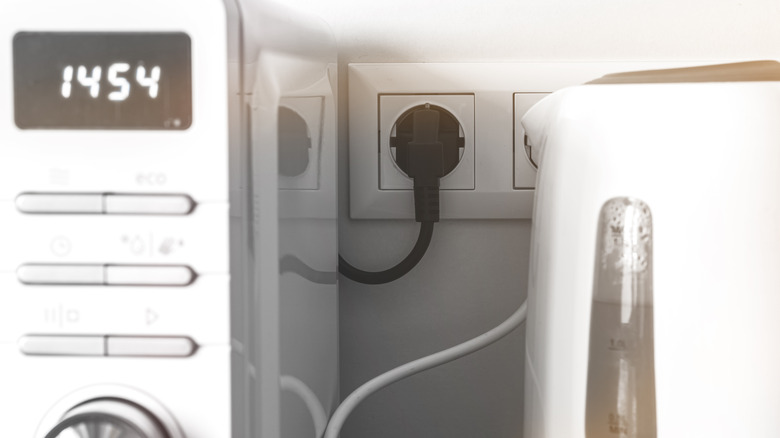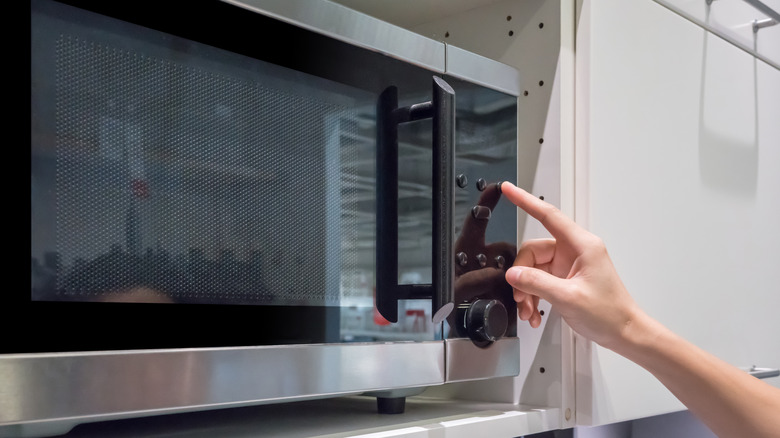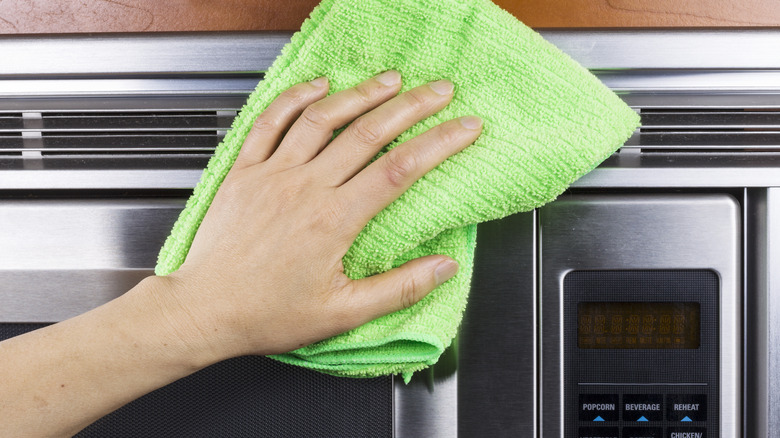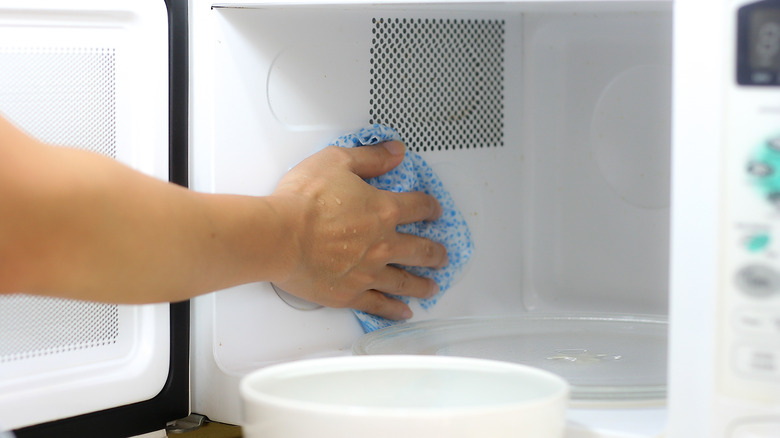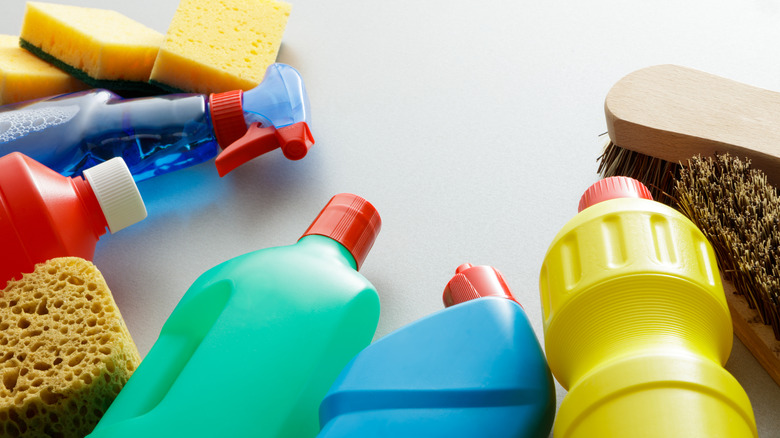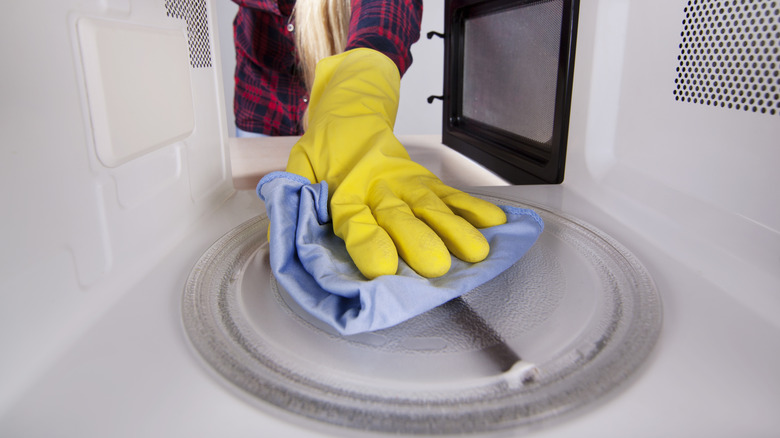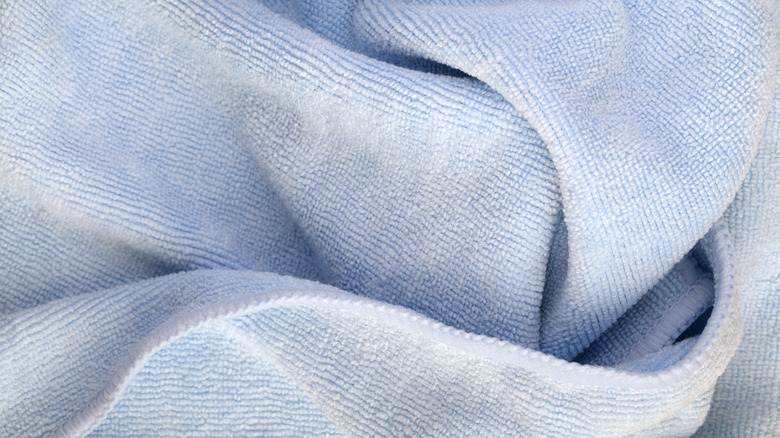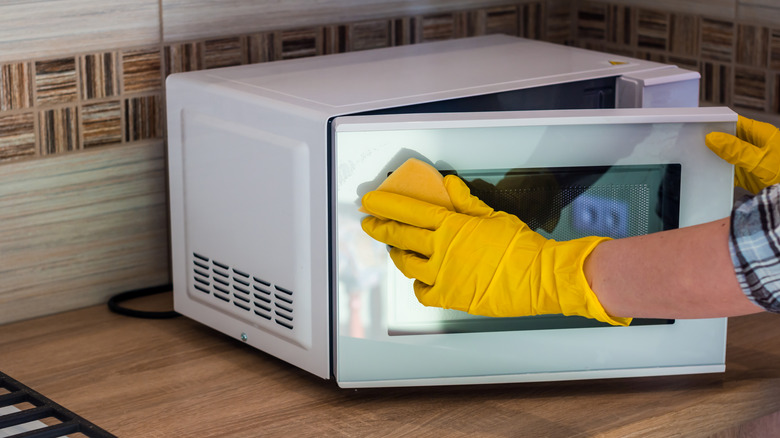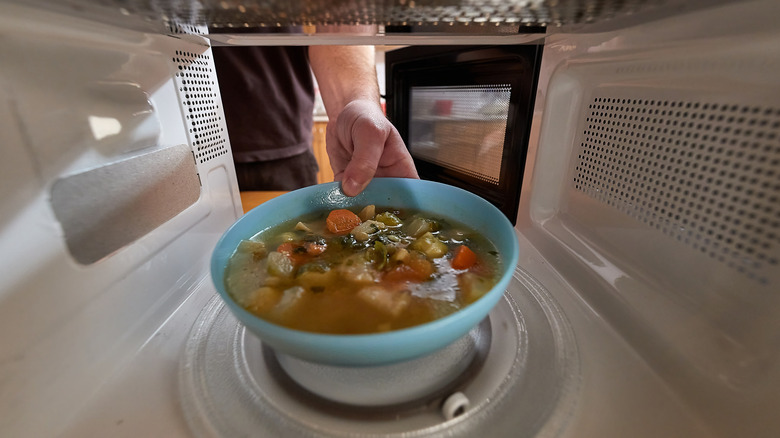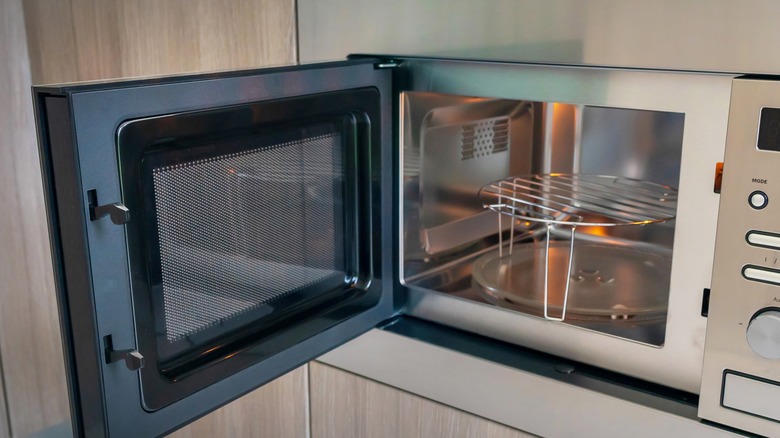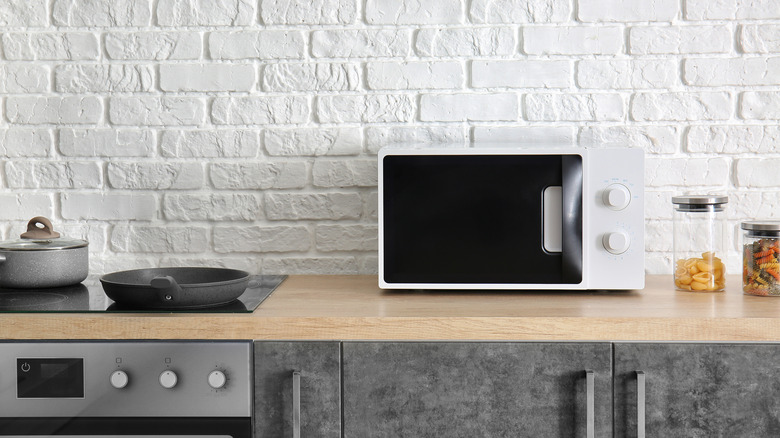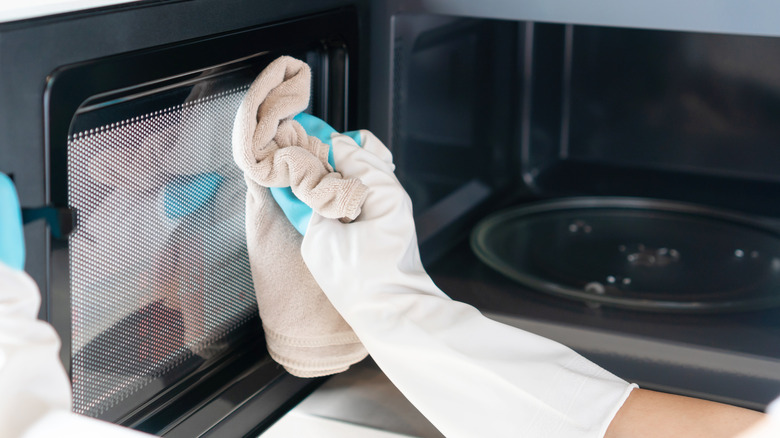12 Microwave Cleaning Mistakes You Need To Avoid
It's no exaggeration to say the microwave oven was a game-changer. A must-have kitchen item now, it was invented accidentally in the 1940s when engineer Percy Spencer was investigating ways to improve access to radar technology. While testing a magnetron, a now-standard component of modern microwave ovens, Spencer found that the peanut cluster bar in his pocket had melted. Just a year later, the first microwave oven was made available commercially. Cut to some 70 years later, and 82% of Americans are in possession of these handy cooking machines, according to Statista.
As a piece of kitchenware that many people use every day, the microwave is put through its paces. Virtually anything can be cooked in a microwave, including a host of things — from like lasagna to mochi to boiled eggs — that you might not know could be prepared in the machine.
As such diverse foods get placed inside, zapped, and taken out, however, residue can build up, leaving you with a substantial clean-up operation. Cleaning a microwave can get complicated; here are some ways to avoid making mistakes.
Forgetting to unplug it
Before you get inside your microwave with cleaning materials, you'll need to unplug it. Like most kitchen gadgets, microwaves operate from a power source. The electrical power from your plug socket provides the energy required for the magnetron inside the oven to cook the food via radiation. The electricity from your main supply also powers the other parts of the microwave, including any lights or buttons on the control panel.
As a result, this is a machine that's riddled with electricity — which can be very harmful. Failing to unplug your microwave before cleaning puts you at risk of exposing yourself to a harmful electric shock. This is doubly dangerous when you consider that the cleaning materials are likely be made of liquid, which may conduct electricity and make an electric shock all the more harmful.
Remember, too, not to immediately clean after unplugging your microwave; instead, give it a little bit of time. It's advised to give the microwave a minimum of 30 seconds before you clean the inside. 30 seconds should give any current that's still in the machine time to move through and dissipate completely. It's a good idea to always check your manufacturer's instructions on cleaning, in case their guidance is different.
Using too much moisture for your control panel
The control panel on your microwave is one of the areas you'll be touching the most, and it can become grimy and covered in fingerprints. This is made even worse if you're touching it with unclean hands, or using the buttons on the panel after touching the food you're making. It's one of those areas in your kitchen that tends to be touched by multiple people throughout the day, increasing the risk of pathogens spreading from person to person, with plastic and touchscreen surfaces being particular hotspots for germs.
This is why cleaning your control panel is so important — but doing so requires a light touch. Microwave control panels can be frustratingly bad at resisting moisture; if you use too much, or employ harsh chemicals, you can damage them, making your microwave oven essentially useless.
To avoid this, limit the amount of moisture you use, and keep it simple. Just use a clean, damp cloth, with a little vinegar solution if the control panel is especially grimy. Follow this up with a thorough wipe using a dry microfiber cloth, so that you don't get water streaks. If your control panel has knobs or buttons, you may want to also use a toothbrush to remove hard-to-reach dirt. Be sure to avoid getting any moisture inside the machine.
Forgetting to clean your vent
Where does all that steam go from the food you're making in the microwave? Usually, straight out of the vent.
Microwaves are often equipped with two vents, located in different parts of the machine: The exhaust grill that sits underneath the machine, and a second vent located on the top. In some models, a vent may also be on the side of the machine. These vents are prone to becoming dirty, because every time you cook food, any moisture that comes off it passes straight through them, and food residue or splatter can also cause them to get unclean.
Some microwave models may make it difficult to access the vent's interior, but if yours can be removed, it's important to clean it monthly. Once you've ensured that your microwave is turned off, remove the plate or grill covering your vent. You may need to unscrew this if it's attached securely or use a latch to pop it off. Remove the vent and soak it in a cleaning solution of water and soap, or water and vinegar. This will allow any built-up residue to soften, making it easier to scrub.
Then, use a brush to gently clean the vent. Allow it to air-dry (ideally overnight, to ensure all the water's gone), before placing it back into your machine.
Leaving it too long between cleans
When was the last time you cleaned your microwave? Probably not recently enough.
Microwaves get dirty quickly, with food splatter produced when you're cooking having nowhere to go except the insides of the machine's walls. When this happens, there are several consequences. Your microwave will start to smell of whatever you've cooked, which is hardly a pleasant culinary experience. To add to this, food splatters that aren't cleaned up immediately run the risk of developing bacteria. Importantly, while your microwave may heat your food, it won't necessarily get hot enough to kill any bacteria lurking inside, and so the longer you leave it, the longer pathogens have to breed.
Failing to clean your microwave regularly also means that any food residue will simply build up, making your machine more difficult to clean next time and potentially shortening its lifespan. As such, you should be aiming to clean your microwave once a week at the bare minimum. But if you end up cooking a particularly messy meal, or have a spillage, then it's best to get cleaning right away. Lastly, don't just let small splatters linger; they have a habit of becoming stubborn and hard to clean. Wipe as you go.
Using abrasive chemicals
If your microwave is looking particularly dirty, or if you simply want to give it a thorough clean, it can be tempting to reach for the hard stuff. But using hardcore chemicals may not be the answer.
Chemical cleaners should never be near your food, and in many cases simply aren't necessary. Bleach is a particular no-no, says The Green Broom president Andrea Holzer. "You can get rid of the bacteria and germs without using this harsh chemical, and you certainly don't want to heat up your food in this environment," Holzer said recently to Reader's Digest. Holzer also highlights the particularly pungent smell that bleach has, which can stick around long after you've finished cleaning.
The best bet for your microwave is to use natural cleaning solutions that are both non-abrasive and don't smell too strong. Vinegar solutions are especially useful for cutting through any greasy residue, and vinegar has the added advantage of being affordable. Another quick and easy way to blast the inside of your machine is to combine water and lemon slices and microwave it until it steams. The lemon will help to combat any food smells that have built up in your machine, and the steaming action will soften any built-up grime, making it easier to wipe away with a cloth.
Neglecting your turntable
The turntable is an essential part of any microwave, rotating continually while the machine operates to ensure food is cooking evenly. But like any other part, it can get dirty. Turntables are prone to dirt and food residue from spillages, resulting in significant areas of build-up. If the food spills under the turntable, that can also create issues with its ability to rotate effectively, potentially affecting how well the food cooks.
Fortunately, cleaning the turntable is a breeze. They are removable parts of the microwave, and since they're made of glass, take very little effort to clean. You can either clean your turntable by hand, using a wet, soapy dishcloth, or by placing it in the dishwasher and cleaning it alongside your plates and cutlery on a regular cycle.
Just bear in mind that while turntables are usually made from tough, thick glass, that doesn't mean they're shatter-proof. Be careful when cleaning, as you won't be able to use your microwave if you drop and break it, and depending on the manufacturer, it may be difficult to find a replacement. Additionally, never use cold water to clean a turntable that's still warm from the microwave; doing so could cause it to shatter.
Using a tough brush
If the food residue in your microwave is particularly thick, you may feel the need to resort to heavy-duty measures, like using an abrasive brush. It's best to keep things soft, as abrasive brushes like those made from steel wool or other scouring materials can damage the inside of your microwave, scratching the interior walls and potentially limiting its function.
Cleaning the outside of your microwave with a tough brush can have an even more noticeable effect. If you're using one to tackle the control panel, you could even render it inoperable.
Avoid such concerns entirely by using a soft cleaning cloth to tackle your dirt. A microfiber cloth is an ideal tool; they are so effective at cleaning because their unique construction affords a huge amount of surface area, giving them an unparalleled ability to pick up dirt, instead of just moving it around. Their positive charge allows them to attract grime and dust, and they are super absorbent, not requiring the use of tough cleaning chemicals to get the job done.
Forgetting to clean your microwave door
If you're cleaning your microwave walls and not the door, you're missing a key step. Microwave doors contain windows to allow you to see your food as it cooks, as well as to keep radiation from escaping the machine and moving into the kitchen. Since microwave doors are see-through, this means food residue shows up even more obviously.
Cleaning a microwave door, however, requires different methods for each side. On the inside, it's advisable to use the same non-abrasive cleaning solution you're using for the rest of the microwave. Microwaving a solution of lemon juice and water can loosen any dried food, which you can then scrub off using a soft-bristled brush or microfiber cloth. On its outside, to keep things shiny, you can use a glass cleaner, which will help get rid of any fingerprints or smudges and keep the machine looking box-fresh.
While you can be a little more liberal with the ingredients of your glass cleaner here, it's always recommended to use natural products, especially on any machines that cook food.
Not avoiding the magnetron
The thing that powers your microwave is also the thing you should be most careful about. The magnetron in every microwave is what gives the machine its cooking power, and when it's fired up by electricity, the magnetron oscillates, dispersing heated electrons into the oven. These electrons penetrate the food you have inside, causing it to heat up and cook, oftentimes much more quickly than if they were in a regular gas or electric oven.
While that may all be super interesting from a science perspective, it's this high-powered action that makes magnetrons dangerous, especially when cleaning.
"It can retain a lethal electrical charge even when unplugged," Calibre Cleaning founder Rocky Vuong tells The Kitchn. "Any issues related to the magnetron should be addressed by a professional technician."
While you're not very likely to come across the magnetron when using the microwave to heat up food, if you're getting deep into your microwave with cleaning equipment, there's a chance you may touch it. Magnetrons are typically covered by panels in a microwave to prevent accidents from happening, but there's always the possibility you could inadvertently come into contact with one.
Avoiding the hinges
The hinges on the microwave door are, at the end of the day, what allows us to get our food in and out of the machine. It's vital, then, that they are kept in good condition. But like any other part of the microwave, hinges can become clogged up with food dirt and remnants. Once that dirt works its way into the gaps and becomes ingrained, it's not as simple as just wiping it away — you may have to replace your microwave entirely.
So, keep your hinges clean. The best way to do this is to incorporate them into your weekly cleaning routine for your microwave; hinges can often be forgotten about, and this can lead to build-up. If you're especially keen to clean in-between the hinges, it may be possible to detach your microwave door by removing the door pins, which will allow you to access them properly. Bear in mind, though, that not all manufacturers will make this the easiest process to perform.
If your hinges are looking especially dirty, or rusty, it may be time to consider getting a new microwave. They will usually last a maximum of about 10 years before requiring replacing. If you use yours heavily, or if it's used by multiple people, it may be wise to get a new one sooner than that.
Not cleaning a new microwave before using it
While it's easy to assume that microwaves can be used straight out of the box, that's not quite the case. New microwaves should ideally be cleaned before you start putting your food inside. This is because there may be residue as a result of the manufacturing process, or perhaps the manufacturer has used materials in its construction that need to be wiped off.
Thankfully, you won't need to be too rigorous about the cleaning process. Generally, a wipe-down with a clean, damp cloth will do the trick, both on the inside and outside. If you want to make sure it's super-clean, you can use a light solution made from a household acid, like white vinegar or lemon juice, and water.
When you do finally use your microwave, if it gives off a strange smell, don't worry. This is simply the circuit board heating up for the first time. While this smell can be pretty strong in some cases, akin to burning plastic, it's nothing to get concerned about, and it will likely dissipate after you use it a few times. If you're concerned about the impact it might have on the taste of your food, you can always run the microwave without anything in it for a few sessions before cooking anything inside.
Forgetting to dry things at the end
Once your microwave is looking shiny, there's one more key step: Drying it all off. It's not only satisfying, and gets it ready for re-use, but it also stops some of its specific parts from getting damaged. If you're cleaning your control panel, for example, you should dry it immediately afterward, as allowing moisture to linger could potentially cause it to drip and work its way inside the circuitry.
Your hinges, too, should be dried thoroughly after you've cleaned them. Hinges are troublesome if moisture gets between them because it could linger, potentially causing rust. In a worst-case scenario, this will result in the hinges becoming stiff or even inoperable. Drying your microwave after cleaning it follows the same principle as cleaning it — the lighter the better. Opt for a microfiber cloth or a soft paper towel, and avoid using abrasive materials so you don't end up scratching your machine.
